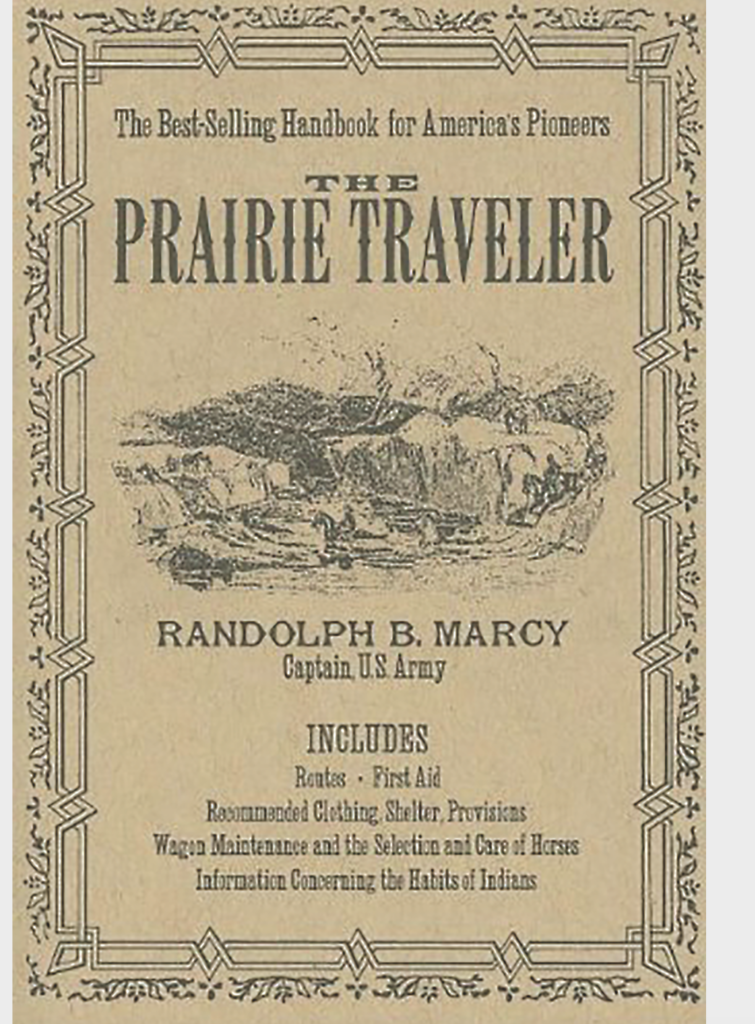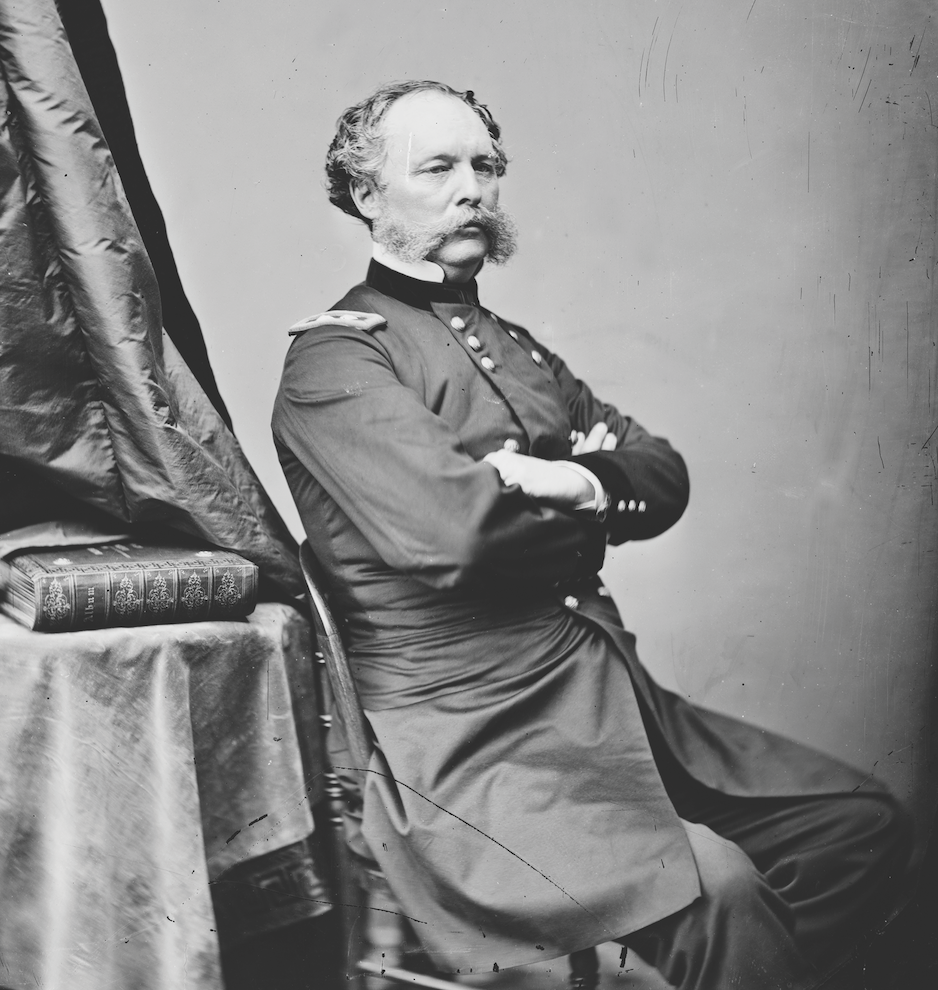Randolph Marcy was a U.S. Army brigadier general and Western explorer whom historians have favorably compared with Zebulon Pike and John Frémont.
A career soldier, he fought in three major conflicts—the Mexican, Third Seminole and Civil wars—and later served as inspector general of the Army. But Marcy achieved lasting fame as author of a small book one modern historian describes as “perhaps the single most important work on the conduct of frontier expeditions.”
Published in 1859, “The Prairie Traveler”—subtitled A Hand-Book for Overland Expeditions, With Maps, Illustrations and Itineraries of the Principal Routes Between the Mississippi and the Pacific—was aimed at those hardy souls planning to trek across the Plains to California and Oregon.
GET HISTORY’S GREATEST TALES—RIGHT IN YOUR INBOX
Subscribe to our HistoryNet Now! newsletter for the best of the past, delivered every Monday and Thursday.
Marcy filled its pages with advice and suggestions—e.g. the wood of the Osage orange tree is best for making wagon wheels, and “ardent spirits” are ideal for treating rattlesnake bites—gleaned during his own expeditions on the Great Plains, as well as from other studies.
Without his book, one commentator writes, Americans’ great Western migration may have gone down in history as a disaster rather than the epic struggle and success it was.
FROM EAST TO THE WEST
Randolph Barnes Marcy was born in Greenwich, Mass., on April 9, 1812. He graduated from the U.S. Military Academy at West Point in 1832 and was commissioned a second lieutenant with the 5th U.S. Infantry in the upper Midwest. He first saw action in the Mexican War, at the 1846 Battles of Palo Alto and Resaca de la Palma, earning promotion to captain.
Assigned in 1848 to command Fort Towson in Indian Territory (present-day Oklahoma), Captain Marcy spent the next several years escorting westbound wagon trains and survey parties through Indian Territory and Texas. In 1849 he traveled from Fort Smith, Ark., to Santa Fe in the newly acquired territory of New Mexico while scouting a Western route across the Texas Panhandle and south of the Canadian River.
By the end of the California Gold Rush in the mid-1850s some 300,000 emigrants had flooded west, about half of them by land, many along the Marcy Trail. (The remainder braved the sea route around Cape Horn or sailed to Panama, crossed the isthmus and continued by ship to the West Coast.)

In 1852 Marcy headed a 70-man expedition in search of the source of the Red River—which rises in the Texas Panhandle, flows along the Texas-Oklahoma border and dips a toe into Arkansas before joining the Mississippi in Louisiana—a feat that had eluded earlier explorers.
Over three months Marcy and party traversed and mapped 1,000 miles of previously unexplored territory, discovering the source of both forks of the river as well as Palo Duro and Tule canyons. The expedition also learned the whereabouts of Texan captive Cynthia Ann Parker, whom raiding Comanches had seized as a child 16 years earlier. By then she was the mother of future Comanche Chief Quanah Parker.
FROZEN FEET AND DEAD MEN
In 1857 Marcy served briefly in Florida during the Third Seminole War before returning to the Midwest, first on the high Plains and then farther west as part of the Army’s Utah Expedition against the Mormons. That winter Marcy led 40 men on a 634-mile forced march from northern Utah Territory to New Mexico Territory through the Rocky Mountains in the dead of winter to gather supplies for isolated Fort Bridger. Though the party ran out of provisions two weeks short of its destination, Marcy brought his men through without any loss of life.
“We were all greatly emaciated,” Marcy recalled in the February 1888 issue of Harper’s New Monthly Magazine, “and 12 of the soldiers had their feet and legs frozen so badly that they had to be carried upon the poor mules, only 18 of which remained alive at the terminus of our journey.”
The Army promptly made Marcy acting inspector general of the Department of Utah. But his expedition to the headwaters of the Red River, his experience guiding emigrants, his relief of Fort Bridger and the well-written reports he had submitted along the way had attracted the attention of the War Department, which put him on special duty—to write a guidebook for westbound emigrants, who were suffering sizable losses. Officials believed such losses were due to a lack of reliable information about the challenges of such a journey and how to plan for it. It assigned Marcy to supply that information.
New York firm Harper & Bros. published the resulting work in 1859. “The life of the wilderness is an art,” its author writes in the preface, before sharing 250 pages of advice over seven chapters on everything from choosing the correct route west to what to pack (provisions for 110 days from the Missouri River to California), when to leave (March or April) and how to choose a saddle, tend animals, make trail repairs, start a fire, approach Indians, and ford rivers and streams (when swimming a horse across a river, he advises, don’t remain in the saddle but cling to its tail and swim behind it).
Marcy peppers the text with personal anecdotes and includes advice from such sources as Charles Darwin, Turkish and French adventurers in North Africa and the Sahara, French and British medical journals and Mexican mule packers.
He also informs readers about the wildlife they might encounter en route, including grizzly bears (“one of the most formidable and savage animals in the universe”), bighorn sheep (whose flesh, he writes, “when fat, is more tender, juicy and delicious than that of any other animal I know of”), the pronghorn (which “possesses a greater degree of curiosity than any other animal”) and the buffalo (whose “sense of smelling is [so] exceedingly accurate…they will take the wind from the hunter at as great a distance as a mile”).
WARNINGS ABOUT VIOLENT CLASHES
Marcy devotes the greater part of one chapter to the feared Indians. “No people probably on the face of the earth are more ambitious of martial fame or entertain a higher appreciation for the deeds of a daring and successful warrior,” he writes. “A small number of white men, in traveling upon the Plains, should not allow a party of strange Indians to approach them unless able to resist an attack under the most unfavorable circumstances.”
The book contains 21 illustrations, including such objects as a California saddle, how exactly to swim a horse and the mathematics involved in crossing a stream. It also provides an appendix with instructions on using a portable boat, traveling in winter and interpreting Indian signs.
On completing the book, the newly promoted Major Marcy was posted to the Pacific Northwest, where he served as a paymaster until the outbreak of the Civil War. He returned east to serve as chief of staff to his son-in-law, Maj. Gen. George B. McClellan, during the latter’s command of the Union Army. By 1865 Marcy had risen to the rank of brevet major general and was serving as an inspector general of the Army, a position he continued to hold after the war.
Marcy retired from active service in 1881 after more than four decades in the Army. He died on Nov. 22, 1887, at his home in West Orange, N.J. By then he had written and published two memoirs: Thirty Years of Army Life on the Border (1866) and Border Reminiscences (1872).
This story originally appeared in the April 2017 print edition of Wild West.
historynet magazines
Our 9 best-selling history titles feature in-depth storytelling and iconic imagery to engage and inform on the people, the wars, and the events that shaped America and the world.






